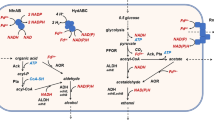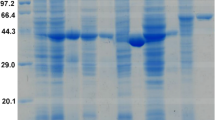Abstract
The reduction of organic acids to their corresponding alcohols has been shown for some bacterial species within the Firmicutes super-phylum and a genetically modified strain of the hyperthermophilic archaeon Pyrococcus furiosus. In the latter strain, an aldehyde:ferredoxin oxidoreductase (AOR) catalyzed the reduction of a variety of organic acids to their corresponding aldehydes, as shown by the deletion of the corresponding aor gene. Here, we found that the genomes of a few thermophilic bacterial species within the genus Thermoanaerobacter which have been described to efficiently ferment sugars to ethanol harbor a copy of aor, while others do not. Specific AOR activity was only found in strains with aor, and the gene was highly expressed in Thermoanaerobacter sp. strain X514. The reduction of a variety of organic acids was observed for several Thermoanaerobacter sp.; however, strains with aor reduced, e.g., isobutyrate at much higher rates of up to 5.1 mM h−1 g−1. Organic acid reduction also led to increased growth rates in Thermoanaerobacter sp. strain X514 and in Thermoanaerobacter pseudethanolicus. Organic acid activation may proceed via acyl-CoA with subsequent NADH-dependent reduction by an aldehyde dehydrogenase (ALDH), or via direct reduction by AOR. Cell-free extracts of Thermoanaerobacter sp. strain X514 exhibited both enzyme activities at comparable rates. Therefore, the biochemistry of organic acid reduction to alcohols in Thermoanaerobacter sp. remains to be elucidated; however, relatively high specific activities and the correlation of AOR specific activities with alcohol production rates suggest a role for AOR.




Similar content being viewed by others
References
Akhtar MK, Dandapani H, Thiel K, Jones PR (2015) Microbial production of 1-octanol: a naturally excreted biofuel with diesel-like properties. Metab Eng Commun 2:1–5. https://doi.org/10.1016/j.meteno.2014.11.001
Artzi L, Bayer EA, Morais S (2017) Cellulosomes: bacterial nanomachines for dismantling plant polysaccharides. Nat Rev Microbiol 15(2):83–95. https://doi.org/10.1038/nrmicro.2016.164
Atsumi S, Hanai T, Liao JC (2008) Non-fermentative pathways for synthesis of branched-chain higher alcohols as biofuels. Nature 451(7174):86–U13
Basen M, Schut GJ, Nguyen DM, Lipscomb GL, Benn RA, Prybol CJ, Vaccaro BJ, Poole FL, Kelly RM, Adams MWW (2014) Single gene insertion drives bioalcohol production by a thermophilic archaeon. Proc Natl Acad Sci U S A 111(49):17618–17623
Bertsch J, Siemund AL, Kremp F, Müller V (2016) A novel route for ethanol oxidation in the acetogenic bacterium Acetobacterium woodii: the acetaldehyde/ethanol dehydrogenase pathway. Environ Microbiol 18(9):2913–2922. https://doi.org/10.1111/1462-2920.13082
Bock M, Kneifel H, Schoberth SM, Sahm H (2000) Reduction of halogenated derivatives of benzoic acid to the corresponding alcohols by Desulfovibrio vulgaris PY1. Acta Biotechnol 20(3–4):189–201. https://doi.org/10.1002/abio.370200303
Bradford MM (1976) Rapid and sensitive method for quantitation of microgram quantities of protein utilizing principle of protein-dye binding. Anal Biochem 72(1–2):248–254
Branduardi P, de Ferra F, Longo V, Porro D (2014) Microbial n-butanol production from Clostridia to non-Clostridial hosts. Eng Life Sci 14(1):16–26. https://doi.org/10.1002/elsc.201200146
Burdette DS, Jung SH, Shen GJ, Hollingsworth RI, Zeikus JG (2002) Physiological function of alcohol dehydrogenases and long-chain (C30) fatty acids in alcohol tolerance of Thermoanaerobacter ethanolicus. Appl Environ Microbiol 68(4):1914–1918
Conway JM, McKinley BS, Seals NL, Hernandez D, Khatibi PA, Poudel S, Giannone RJ, Hettich RL, Williams-Rhaesa AM, Lipscomb GL, Adams MWW, Kelly RM (2017) Functional analysis of the Glucan Degradation Locus (GDL) in Caldicellulosiruptor bescii reveals essential roles of component glycoside hydrolases in plant biomass deconstruction. Appl Environ Microbiol 83:e01828–e01817. https://doi.org/10.1128/aem.01828-17
Diender M, Stams AJM, Sousa DZ (2016) Production of medium-chain fatty acids and higher alcohols by a synthetic co-culture grown on carbon monoxide or syngas. Biotechnol Biofuels 9(1):82. https://doi.org/10.1186/s13068-016-0495-0
Dürre P (2008) Fermentative butanol production: bulk chemical and biofuel. Ann N Y Acad Sci 1125:353–362. https://doi.org/10.1196/annals.1419.009
Fraisse L, Simon H (1988) Observations on the reduction of non-activated carboxylates by Clostridium formicoaceticum with carbon monoxide or formate and the influence of various viologens. Arch Microbiol 150(4):381–386
Generoso WC, Schadeweg V, Oreb M, Boles E (2015) Metabolic engineering of Saccharomyces cerevisiae for production of butanol isomers. Curr Opin Biotechnol 33:1–7. https://doi.org/10.1016/j.copbio.2014.09.004
Genthner BR, Townsend GT, Blattmann BO (1997) Reduction of 3-chlorobenzoate, 3-bromobenzoate, and benzoate to corresponding alcohols by Desulfomicrobium escambiense, isolated from a 3-chlorobenzoate-dechlorinating coculture. Appl Environ Microbiol 63(12):4698–4703
Isken S, de Bont JA (1998) Bacteria tolerant to organic solvents. Extremophiles 2(3):229–238
Isom CE, Nanny MA, Tanner RS (2015) Improved conversion efficiencies for n-fatty acid reduction to primary alcohols by the solventogenic acetogen “Clostridium ragsdalei”. J Ind Microbiol Biotechnol 42(1):29–38
Keller MW, Lipscomb GL, Loder AJ, Schut GJ, Kelly RM, Adams MWW (2015) A hybrid synthetic pathway for butanol production by a hyperthermophilic microbe. Metab Eng 27:101–106. https://doi.org/10.1016/j.ymben.2014.11.004
Liew F, Henstra AM, Kӧpke M, Winzer K, Simpson SD, Minton NP (2017) Metabolic engineering of Clostridium autoethanogenum for selective alcohol production. Metab Eng 40:104–114. https://doi.org/10.1016/j.ymben.2017.01.007
Livak KJ, Schmittgen TD (2001) Analysis of relative gene expression data using real-time quantitative PCR and the 2−ΔΔCT method. Methods 25(4):402–408. https://doi.org/10.1006/meth.2001.1262
Lovitt RW, Shen GJ, Zeikus JG (1988) Ethanol production by thermophilic bacteria: biochemical basis for ethanol and hydrogen tolerance in Clostridium thermohydrosulfuricum. J Bacteriol 170(6):2809–2815
Lynd LR, Liang X, Biddy MJ, Allee A, Cai H, Foust T, Himmel ME, Laser MS, Wang M, Wyman CE (2017) Cellulosic ethanol: status and innovation. Curr Opin Biotechnol 45:202–211. https://doi.org/10.1016/j.copbio.2017.03.008
Mukund S, Adams MWW (1991) The novel tungsten-iron-sulfur protein of the hyperthermophilic archaebacterium, Pyrococcus furiosus, is an aldehyde ferredoxin oxidoreductase - evidence for its participation in a unique glycolytic pathway. J Biol Chem 266(22):14208–14216
Napora-Wijata K, Strohmeier GA, Winkler M (2014) Biocatalytic reduction of carboxylic acids. Biotechnol J 9(6):822–843
Nielsen J, Larsson C, van Maris A, Pronk J (2013) Metabolic engineering of yeast for production of fuels and chemicals. Curr Opin Biotechnol 24(3):398–404. https://doi.org/10.1016/j.copbio.2013.03.023
Olson DG, Sparling R, Lynd LR (2015) Ethanol production by engineered thermophiles. Curr Opin Biotechnol 33:130–141
Paye JMD, Guseva A, Hammer SK, Gjersing E, Davis MF, Davison BH, Olstad J, Donohoe BS, Nguyen TY, Wyman CE, Pattathil S, Hahn MG, Lynd LR (2016) Biological lignocellulose solubilization: comparative evaluation of biocatalysts and enhancement via cotreatment. Biotechnol Biofuels 9(1):8. https://doi.org/10.1186/s13068-015-0412-y
Pei J, Zhou Q, Jing Q, Li L, Dai C, Li H, Wiegel J, Shao W (2011) The mechanism for regulating ethanol fermentation by redox levels in Thermoanaerobacter ethanolicus. Metab Eng 13(2):186–193. https://doi.org/10.1016/j.ymben.2010.12.006
Pei JJ, Zhou Q, Jiang Y, Le YL, Li HZ, Shao WL, Wiegel J (2010) Thermoanaerobacter spp. control ethanol pathway via transcriptional regulation and versatility of key enzymes. Metab Eng 12(5):420–428. https://doi.org/10.1016/j.ymben.2010.06.001
Peralta-Yahya PP, Zhang F, del Cardayre SB, Keasling JD (2012) Microbial engineering for the production of advanced biofuels. Nature 488(7411):320–328
Perez JM, Richter H, Loftus SE, Angenent LT (2013) Biocatalytic reduction of short-chain carboxylic acids into their corresponding alcohols with syngas fermentation. Biotechnol Bioeng 110(4):1066–1077
Richter H, Qureshi N, Heger S, Dien B, Cotta MA, Angenent LT (2012) Prolonged conversion of n-butyrate to n-butanol with Clostridium saccharoperbutylacetonicum in a two-stage continuous culture with in-situ product removal. Biotechnol Bioeng 109(4):913–921
Richter H, Molitor B, Wei H, Chen W, Aristilde L, Angenent LT (2016) Ethanol production in syngas-fermenting Clostridium ljungdahlii is controlled by thermodynamics rather than by enzyme expression. Energy Environ Sci 9(7):2392–2399. https://doi.org/10.1039/C6EE01108J
Roy R, Menon AL, Adams MWW (2001) Aldehyde oxidoreductases from Pyrococcus furiosus. In: Michael WW, Adams RMK (eds) Method Enzymol, vol 331. Academic Press, pp 132–144
Schmidt K, Jensen SL, Schlegel H (1963) Die Carotinoide der Thiorhodaceae. Arch Mikrobiol 46(2):117–126
Simon H, White H, Lebertz H, Thanos I (1987) Reduction of 2-enoates and alkanoates with carbon monoxide or formate, viologens, and Clostridium thermoaceticum to saturated acids and unsaturated and saturated alcohols. Angew Chem Int Edit 26(8):785–787
Thauer RK, Jungermann K, Decker K (1977) Energy conservation in chemotropic anaerobic bacteria. Bacteriol Rev 41(1):100–180
Tilman D, Socolow R, Foley JA, Hill J, Larson E, Lynd L, Pacala S, Reilly J, Searchinger T, Somerville C (2009) Beneficial biofuels—the food, energy, and environment trilemma. Science 325(5938):270–271
Verbeke TJ, Zhang XL, Henrissat B, Spicer V, Rydzak T, Krokhin OV, Fristensky B, Levin DB, Sparling R (2013) Genomic evaluation of Thermoanaerobacter spp. for the construction of designer co-cultures to improve lignocellulosic biofuel production. PLoS One 8(3):e59362. https://doi.org/10.1371/journal.pone.0059362
Weghoff MC, Müller V (2016) CO metabolism in the thermophilic acetogen Thermoanaerobacter kivui. Appl Environ Microbiol 82(8):2312–2319. https://doi.org/10.1128/aem.00122-16
White H, Strobl G, Feicht R, Simon H (1989) Carboxylic acid reductase—a new tungsten enzyme catalyzes the reduction of non-activated carboxylic acids to aldehydes. Eur J Biochem 184(1):89–96
Widdel F, Bak F (1992) Gram-negative mesophilic sulfate-reducing bacteria. In: Balows AT, H.G.; Dworkin, M., Harder, W.; and Schleifer, K.-H. (ed) The prokaryotes. Springer, New York, pp 3352–3378
Wiegel J, Ljungdahl LG (1981) Thermoanaerobacter ethanolicus gen. nov., spec. nov., a new extreme thermophilic anaerobic bacterium. Arch Microbiol 128(4):343–348
Wolin EA, Wolin MJ, Wolfe RS (1963) Formation of methane by bacterial extracts. J Biol Chem 238:2882–2886
Yang SJ, Kataeva I, Hamilton-Brehm SD, Engle NL, Tschaplinski TJ, Doeppke C, Davis M, Westpheling J, Adams MWW (2009) Efficient degradation of lignocellulosic plant biomass, without pretreatment, by the thermophilic anaerobe “Anaerocellum thermophilum” DSM 6725. Appl Environ Microbiol 75(14):4762–4769. https:/doi.org/https://doi.org/10.1128/Aem.00236-09
Yang SJ, Kataeva I, Wiegel J, Yin YB, Dam P, Xu Y, Westpheling J, Adams MWW (2010) Classification of ‘Anaerocellum thermophilum’ strain DSM 6725 as Caldicellulosiruptor bescii sp. nov. Int J Syst Evol Microbiol 60:2011–2015. https:/doi.org/https://doi.org/10.1099/Ijs.0.017731-0
Yao S, Mikkelsen MJ (2010) Identification and overexpression of a bifunctional aldehyde/alcohol dehydrogenase responsible for ethanol production in Thermoanaerobacter mathranii. J Mol Microbiol Biotechnol 19(3):123–133. https://doi.org/10.1159/000321498
Zhou J, Shao X, Olson DG, Murphy SJ, Tian L, Lynd LR (2017) Determining the roles of the three alcohol dehydrogenases (AdhA, AdhB and AdhE) in Thermoanaerobacter ethanolicus during ethanol formation. J Ind Microbiol Biotechnol 44(4–5):745–757. https://doi.org/10.1007/s10295-016-1896-6
Acknowledgements
We would like to thank Michael W. W. Adams (University of Georgia, Athens, GA, USA) for providing Thermoanaerobacter sp. strain X514 and Volker Müller (Goethe University, Frankfurt/Main) for supporting the project.
Funding
This study was funded by a grant from Deutsche Forschungsgemeinschaft (DFG BA 5757/1-1).
Author information
Authors and Affiliations
Corresponding author
Ethics declarations
Conflict of interest
The authors declare that they have no conflict of interest.
Ethical approval
This article does not contain any studies with human participants or animals performed by any of the authors.
Electronic supplementary material
ESM 1
(PDF 182 kb)
Rights and permissions
About this article
Cite this article
Hitschler, L., Kuntz, M., Langschied, F. et al. Thermoanaerobacter species differ in their potential to reduce organic acids to their corresponding alcohols. Appl Microbiol Biotechnol 102, 8465–8476 (2018). https://doi.org/10.1007/s00253-018-9210-3
Received:
Revised:
Accepted:
Published:
Issue Date:
DOI: https://doi.org/10.1007/s00253-018-9210-3




